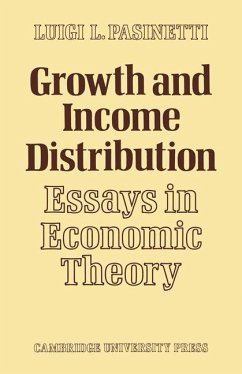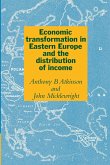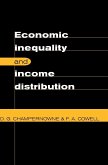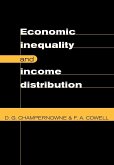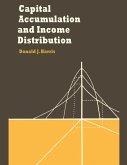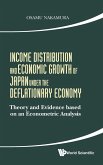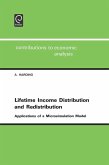- Broschiertes Buch
- Merkliste
- Auf die Merkliste
- Bewerten Bewerten
- Teilen
- Produkt teilen
- Produkterinnerung
- Produkterinnerung
This 1974 collection of six essays in economic theory represents a major contribution to the field.
Andere Kunden interessierten sich auch für
![Economic Transformation in Eastern Europe and the Distribution of Income Economic Transformation in Eastern Europe and the Distribution of Income]() Anthony Barnes AtkinsonEconomic Transformation in Eastern Europe and the Distribution of Income54,99 €
Anthony Barnes AtkinsonEconomic Transformation in Eastern Europe and the Distribution of Income54,99 €![The Distribution of Welfare and Household Production The Distribution of Welfare and Household Production]() Stephen Jenkins / Arie Kapteyn / Bernard van van Praag (eds.)The Distribution of Welfare and Household Production134,99 €
Stephen Jenkins / Arie Kapteyn / Bernard van van Praag (eds.)The Distribution of Welfare and Household Production134,99 €![Economic Inequality and Income Distribution Economic Inequality and Income Distribution]() D. G. ChampernowneEconomic Inequality and Income Distribution86,99 €
D. G. ChampernowneEconomic Inequality and Income Distribution86,99 €![Economic Inequality and Income Distribution Economic Inequality and Income Distribution]() F. A. CowellEconomic Inequality and Income Distribution64,99 €
F. A. CowellEconomic Inequality and Income Distribution64,99 €![Capital Accumulation and Income Distribution Capital Accumulation and Income Distribution]() Donald J. HarrisCapital Accumulation and Income Distribution50,99 €
Donald J. HarrisCapital Accumulation and Income Distribution50,99 €![INCOME DISTRIBUTION AND ECONOMIC GROWTH OF JAPAN UNDER THE.. INCOME DISTRIBUTION AND ECONOMIC GROWTH OF JAPAN UNDER THE..]() Osamu NakamuraINCOME DISTRIBUTION AND ECONOMIC GROWTH OF JAPAN UNDER THE..102,99 €
Osamu NakamuraINCOME DISTRIBUTION AND ECONOMIC GROWTH OF JAPAN UNDER THE..102,99 €![Lifetime Income Distribution and Redistribution Lifetime Income Distribution and Redistribution]() A. HardingLifetime Income Distribution and Redistribution259,99 €
A. HardingLifetime Income Distribution and Redistribution259,99 €-
-
-
This 1974 collection of six essays in economic theory represents a major contribution to the field.
Hinweis: Dieser Artikel kann nur an eine deutsche Lieferadresse ausgeliefert werden.
Hinweis: Dieser Artikel kann nur an eine deutsche Lieferadresse ausgeliefert werden.
Produktdetails
- Produktdetails
- Verlag: Cambridge University Press
- Seitenzahl: 164
- Erscheinungstermin: 2. Juni 2010
- Englisch
- Abmessung: 216mm x 140mm x 10mm
- Gewicht: 216g
- ISBN-13: 9780521295437
- ISBN-10: 0521295432
- Artikelnr.: 24974019
- Herstellerkennzeichnung
- Libri GmbH
- Europaallee 1
- 36244 Bad Hersfeld
- gpsr@libri.de
- Verlag: Cambridge University Press
- Seitenzahl: 164
- Erscheinungstermin: 2. Juni 2010
- Englisch
- Abmessung: 216mm x 140mm x 10mm
- Gewicht: 216g
- ISBN-13: 9780521295437
- ISBN-10: 0521295432
- Artikelnr.: 24974019
- Herstellerkennzeichnung
- Libri GmbH
- Europaallee 1
- 36244 Bad Hersfeld
- gpsr@libri.de
Preface
Part I. A Mathematical Formulation of the Ricardian System: 1. Theory of value
2. Theory of distribution
3. Theory of economic growth
4. 'Natural' equilibrium in a two-commodity system
5. Some characteristics of the Ricardian system
6. The market solutions and the attainment of the 'natural' equilibrium
7. The equilibrium of the stationary state
8. The process of economic growth
9. Multi-commodity production
10. Concluding remarks
Appendix - existence and uniqueness of stable solutions
Part II. The Economics of Effective Demand: 1. Malthus on effective demand
2. The principle of effective demand
3. Theories of under-consumption (And over-production) 4. J. M. Keynes' 'general theory' of employment
5. The principle of effective demand in a different context
6. Ricardian features of effective demand in a different context. 7. Anti-Keynesian features of some 'Keynesian' literature
8. The principle of acceleration
9. Final remarks
Appendix - the 'lagged' multiplier
Part III. Cyclical Fluctuations and Economic Growth: 1. The model
2. A graphical device
3. The dynamics of income
4. The dynamics of the stock of capital
5. Interrelations between the dynamics of capital
6. The various interpretation of the endogenous dynamics of an economic system
7. Possibility of a steady growth
8. The difficulties of providing a theory which may explain both cycles and growth
9. A more flexible use of macro-economic models
10. A reinterpretation of the complex dynamics of a modern economic system
Mathematical appendix
Part IV. From Classical to Keynesian Economic Dynamics: 1. Pre-Malthusian Views on Population
2. Malthus' Principle of population
3. The 'law of diminishing returns'
4. Population growth and technical progress
5. Long-run equilibrium conditions - Domanr's contribution
6. The 'natural rate of growth - Harrod's contribution
7. New answer to an old Ricardian problem
8. Kaldor's theory of income distribution
9. Concluding remarks
Part V. Rate of Profit and Income Distribution in relation to the Rate of Economic Growth: 1. A post-Keynesian theory of income distribution and the rate of profit
2. A correction
3. Reformulating the model
4. Rate and share of profits in relation to the rate of growth
5. A fundamental relation between profits and savings
6. Implications
7. The conditions of stability
8. The case of a socialist system
9. Models and reality
Part VI. The Rate of Profit in and Expanding Economy: 1. Harrod-Domar's dilemma
2. The 'Cambridge equation'
3. The marginal productivity alternative
4. Extreme assumptions and general results
5. A first approximation synthesis
6. Irrelevance of the workers' savings required for the disappearance of the capitalists
9. Capital-output ratio and rate of profit
10. The case of a highly flexible capital-output ratio
11. Conclusions for the general case
12. Rate of interest and rate of profit
13. Many groups of savers
14. Further extensions
15. A socialist economy
16. The rate of profit in an expanding economy
References
Index.
Part I. A Mathematical Formulation of the Ricardian System: 1. Theory of value
2. Theory of distribution
3. Theory of economic growth
4. 'Natural' equilibrium in a two-commodity system
5. Some characteristics of the Ricardian system
6. The market solutions and the attainment of the 'natural' equilibrium
7. The equilibrium of the stationary state
8. The process of economic growth
9. Multi-commodity production
10. Concluding remarks
Appendix - existence and uniqueness of stable solutions
Part II. The Economics of Effective Demand: 1. Malthus on effective demand
2. The principle of effective demand
3. Theories of under-consumption (And over-production) 4. J. M. Keynes' 'general theory' of employment
5. The principle of effective demand in a different context
6. Ricardian features of effective demand in a different context. 7. Anti-Keynesian features of some 'Keynesian' literature
8. The principle of acceleration
9. Final remarks
Appendix - the 'lagged' multiplier
Part III. Cyclical Fluctuations and Economic Growth: 1. The model
2. A graphical device
3. The dynamics of income
4. The dynamics of the stock of capital
5. Interrelations between the dynamics of capital
6. The various interpretation of the endogenous dynamics of an economic system
7. Possibility of a steady growth
8. The difficulties of providing a theory which may explain both cycles and growth
9. A more flexible use of macro-economic models
10. A reinterpretation of the complex dynamics of a modern economic system
Mathematical appendix
Part IV. From Classical to Keynesian Economic Dynamics: 1. Pre-Malthusian Views on Population
2. Malthus' Principle of population
3. The 'law of diminishing returns'
4. Population growth and technical progress
5. Long-run equilibrium conditions - Domanr's contribution
6. The 'natural rate of growth - Harrod's contribution
7. New answer to an old Ricardian problem
8. Kaldor's theory of income distribution
9. Concluding remarks
Part V. Rate of Profit and Income Distribution in relation to the Rate of Economic Growth: 1. A post-Keynesian theory of income distribution and the rate of profit
2. A correction
3. Reformulating the model
4. Rate and share of profits in relation to the rate of growth
5. A fundamental relation between profits and savings
6. Implications
7. The conditions of stability
8. The case of a socialist system
9. Models and reality
Part VI. The Rate of Profit in and Expanding Economy: 1. Harrod-Domar's dilemma
2. The 'Cambridge equation'
3. The marginal productivity alternative
4. Extreme assumptions and general results
5. A first approximation synthesis
6. Irrelevance of the workers' savings required for the disappearance of the capitalists
9. Capital-output ratio and rate of profit
10. The case of a highly flexible capital-output ratio
11. Conclusions for the general case
12. Rate of interest and rate of profit
13. Many groups of savers
14. Further extensions
15. A socialist economy
16. The rate of profit in an expanding economy
References
Index.
Preface
Part I. A Mathematical Formulation of the Ricardian System: 1. Theory of value
2. Theory of distribution
3. Theory of economic growth
4. 'Natural' equilibrium in a two-commodity system
5. Some characteristics of the Ricardian system
6. The market solutions and the attainment of the 'natural' equilibrium
7. The equilibrium of the stationary state
8. The process of economic growth
9. Multi-commodity production
10. Concluding remarks
Appendix - existence and uniqueness of stable solutions
Part II. The Economics of Effective Demand: 1. Malthus on effective demand
2. The principle of effective demand
3. Theories of under-consumption (And over-production) 4. J. M. Keynes' 'general theory' of employment
5. The principle of effective demand in a different context
6. Ricardian features of effective demand in a different context. 7. Anti-Keynesian features of some 'Keynesian' literature
8. The principle of acceleration
9. Final remarks
Appendix - the 'lagged' multiplier
Part III. Cyclical Fluctuations and Economic Growth: 1. The model
2. A graphical device
3. The dynamics of income
4. The dynamics of the stock of capital
5. Interrelations between the dynamics of capital
6. The various interpretation of the endogenous dynamics of an economic system
7. Possibility of a steady growth
8. The difficulties of providing a theory which may explain both cycles and growth
9. A more flexible use of macro-economic models
10. A reinterpretation of the complex dynamics of a modern economic system
Mathematical appendix
Part IV. From Classical to Keynesian Economic Dynamics: 1. Pre-Malthusian Views on Population
2. Malthus' Principle of population
3. The 'law of diminishing returns'
4. Population growth and technical progress
5. Long-run equilibrium conditions - Domanr's contribution
6. The 'natural rate of growth - Harrod's contribution
7. New answer to an old Ricardian problem
8. Kaldor's theory of income distribution
9. Concluding remarks
Part V. Rate of Profit and Income Distribution in relation to the Rate of Economic Growth: 1. A post-Keynesian theory of income distribution and the rate of profit
2. A correction
3. Reformulating the model
4. Rate and share of profits in relation to the rate of growth
5. A fundamental relation between profits and savings
6. Implications
7. The conditions of stability
8. The case of a socialist system
9. Models and reality
Part VI. The Rate of Profit in and Expanding Economy: 1. Harrod-Domar's dilemma
2. The 'Cambridge equation'
3. The marginal productivity alternative
4. Extreme assumptions and general results
5. A first approximation synthesis
6. Irrelevance of the workers' savings required for the disappearance of the capitalists
9. Capital-output ratio and rate of profit
10. The case of a highly flexible capital-output ratio
11. Conclusions for the general case
12. Rate of interest and rate of profit
13. Many groups of savers
14. Further extensions
15. A socialist economy
16. The rate of profit in an expanding economy
References
Index.
Part I. A Mathematical Formulation of the Ricardian System: 1. Theory of value
2. Theory of distribution
3. Theory of economic growth
4. 'Natural' equilibrium in a two-commodity system
5. Some characteristics of the Ricardian system
6. The market solutions and the attainment of the 'natural' equilibrium
7. The equilibrium of the stationary state
8. The process of economic growth
9. Multi-commodity production
10. Concluding remarks
Appendix - existence and uniqueness of stable solutions
Part II. The Economics of Effective Demand: 1. Malthus on effective demand
2. The principle of effective demand
3. Theories of under-consumption (And over-production) 4. J. M. Keynes' 'general theory' of employment
5. The principle of effective demand in a different context
6. Ricardian features of effective demand in a different context. 7. Anti-Keynesian features of some 'Keynesian' literature
8. The principle of acceleration
9. Final remarks
Appendix - the 'lagged' multiplier
Part III. Cyclical Fluctuations and Economic Growth: 1. The model
2. A graphical device
3. The dynamics of income
4. The dynamics of the stock of capital
5. Interrelations between the dynamics of capital
6. The various interpretation of the endogenous dynamics of an economic system
7. Possibility of a steady growth
8. The difficulties of providing a theory which may explain both cycles and growth
9. A more flexible use of macro-economic models
10. A reinterpretation of the complex dynamics of a modern economic system
Mathematical appendix
Part IV. From Classical to Keynesian Economic Dynamics: 1. Pre-Malthusian Views on Population
2. Malthus' Principle of population
3. The 'law of diminishing returns'
4. Population growth and technical progress
5. Long-run equilibrium conditions - Domanr's contribution
6. The 'natural rate of growth - Harrod's contribution
7. New answer to an old Ricardian problem
8. Kaldor's theory of income distribution
9. Concluding remarks
Part V. Rate of Profit and Income Distribution in relation to the Rate of Economic Growth: 1. A post-Keynesian theory of income distribution and the rate of profit
2. A correction
3. Reformulating the model
4. Rate and share of profits in relation to the rate of growth
5. A fundamental relation between profits and savings
6. Implications
7. The conditions of stability
8. The case of a socialist system
9. Models and reality
Part VI. The Rate of Profit in and Expanding Economy: 1. Harrod-Domar's dilemma
2. The 'Cambridge equation'
3. The marginal productivity alternative
4. Extreme assumptions and general results
5. A first approximation synthesis
6. Irrelevance of the workers' savings required for the disappearance of the capitalists
9. Capital-output ratio and rate of profit
10. The case of a highly flexible capital-output ratio
11. Conclusions for the general case
12. Rate of interest and rate of profit
13. Many groups of savers
14. Further extensions
15. A socialist economy
16. The rate of profit in an expanding economy
References
Index.

